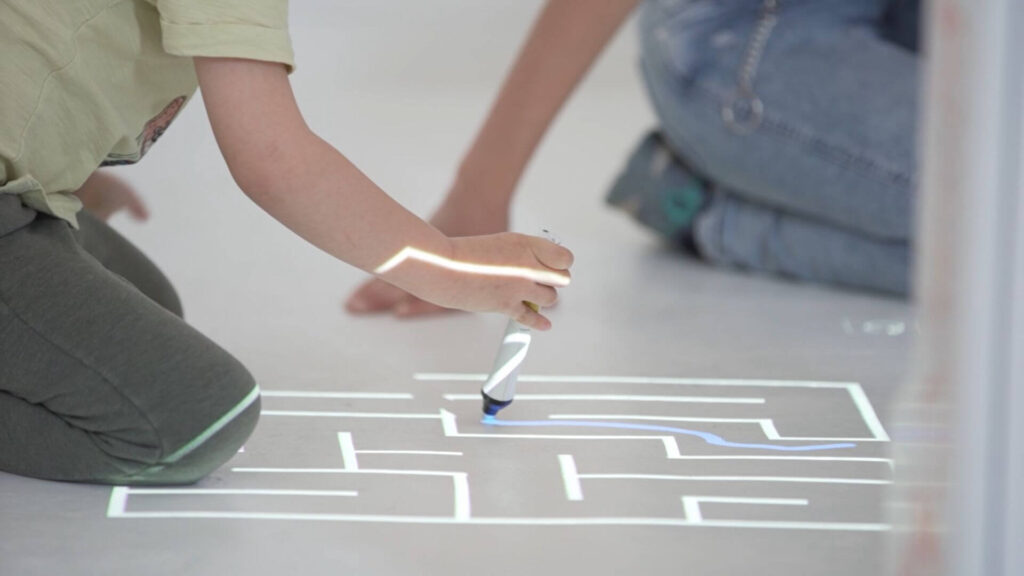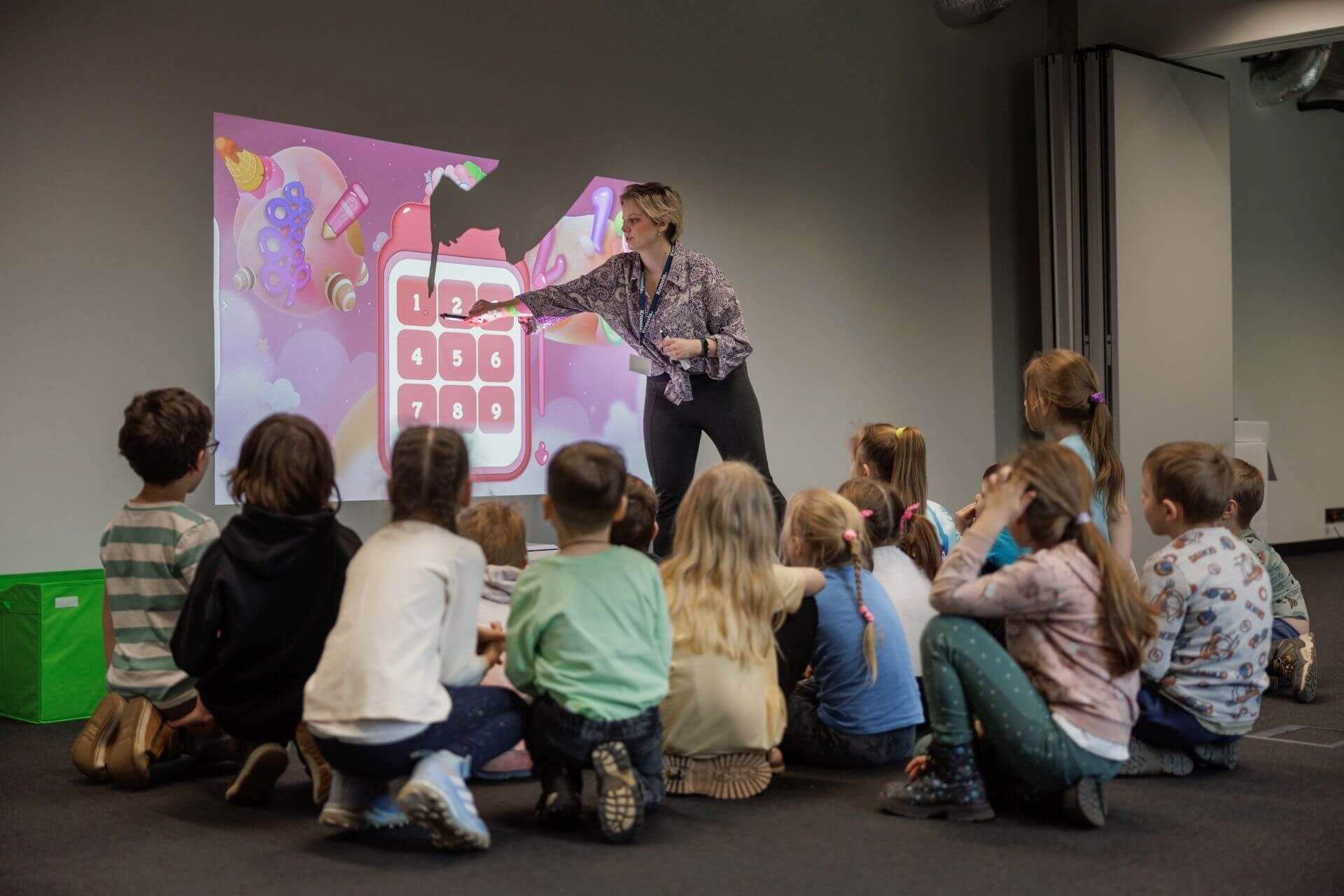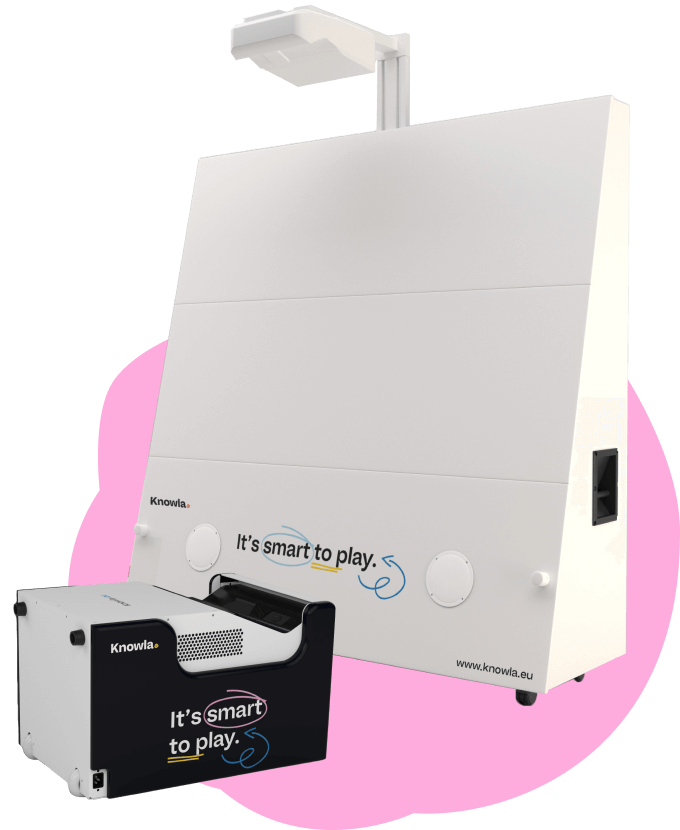Who are you?
Hello! My name is Ursula Skorodziłło and I currently work at Knoocker, which is responsible for the Knowla brand. I create and invent materials that are available on our platforms. I design activities and then test them before they are submitted for sale. Perhaps also importantly, I became a member of Knowl’s Program Council. In turn, before that I studied cognitive science at UAM.
Weren’t you involved in education before?
Don’t. In fact, I never thought I would get serious about anything related to children. Even in college. We had such a subject with the basics of developmental psychology, and I remember exactly how I thought to myself that I didn’t need to go into it more, because… I’m just not going to deal with it in the future. After graduation, I found a job at Knoocker, which became more and more strongly and consciously involved in education, and I found myself in it after time. It was also not that working in education or as a teacher was never in my areas of interest. As a child, this was one of my ideas for life, but over time I realized that, first of all, perhaps I don’t have the right competence or personality traits to work with children and young people all the time. At least that’s my impression so far. Perhaps erroneous. Secondly, and probably much more importantly, I didn’t know what subject or specialized area I would see myself best in. Throughout my education, I didn’t have a subject that I loved. I also didn’t have a subject that went particularly poorly for me. So, as befits such a typical multipotentialist, I found it hard to lock myself into the rigid framework that current education sometimes imposes. From there, I started looking for another way.
Do you think a multipotentialist like you is having a hard time in the education system?
Define hard. Passing school or individual subjects is not much of a problem. Since you are or can be interested in everything, whether we are talking about physics, biology, history or Polish, you will manage enough to pass. In this respect, it is a fairy tale. You can do to your heart’s content a little bit of everything. The problem begins more after school, where the world requires specialization in an area…. profession. It’s hard to cover everything that interests you in one career. As if I had to say, all sorts of specialists may have a harder time in the school itself. Take the cliched stereotype of the humanist and mathematician. Here, there may be a greater struggle for survival on unloved items. For that, it may be much easier for them to orient themselves in the future.
Eventually you decided to study cognitive science. Why and what is it actually?
Choosing the direction myself, I did not know exactly what it was. Even my professors had a problem with a concrete definition of this direction. After high school graduation, I didn’t have a good plan for the future. One of my ideas didn’t work out, so I started looking for something quick for a year or so to keep me from sitting idle. I applied for cognitive science because I was interested in psychology, but precisely, as I realized then, one more in the cognitive stream, not psychodynamic, humanistic or any other. I also didn’t see myself in an office, seeing patients, and that was the future I mostly associated with studying psychology. Besides, as I read, cognitive science didn’t just consist of this psychology, but also anthropology, neuroscience, philosophy, linguistics, or artificial intelligence. Speaking of multipotentialist, in what other studies would I find such a mix? Cognitive science is not a science in itself. He is just working interdisciplinarily at the interface of the above-mentioned sciences. What does this mean in practice? There is no single consistent dogma. We respect and delve into each of the sciences mentioned, looking for similarities, differences, solutions that could be transferred from one field to another…. Such will probably be our overall goal precisely to unravel the riddle of our brain and mind, and thus to unify the knowledge of the mentioned sciences that deal with this topic within their clique. How do we learn about the world? How do we make decisions? Can artificial intelligence be like us? And so on. Despite many centuries of consideration, we still know little about the subject.
So was it accidentally a hit?
Yes. I had a great time.
You mentioned artificial intelligence. How do you see it now and in the future?
I am not a great expert in this field, because I do not deal with it or observe its achievements intensively. For me, meeting a chatbot with which it was reasonably humanly possible to chat, or other generators, was not a big surprise, as they appeared in wide access. I was well aware that, in a greater or lesser way, AI has accompanied us for a long time. It is not the man who segregated your Facebook posts better and better. I saw it as the next step, while at the same time I was curious to see more and more enthusiasts with the topic. And I also have the impression of a change in thinking about AI. When I was in college, hearing about artificial intelligence I had in my mind all those almost human operating systems or androids from movies, not GPT chat. Now the first thought is support systems or generating shuttles and images. I know people who say that in five years we will be amazed at what AI can accomplish and what it can do for us. To a certain extent, I agree. This is the role of technological progress, which, although it seems to be slowing down a bit, is still dynamic. Some things could probably be automated quite easily. But on the other hand, when I think of all that artificial intelligence can do, I would give maybe ten, twenty… maybe more. It all depends on a number of factors and the problems we encounter along the way. However, there’s no getting around the fact that it won’t be useful for anything, because it’s already slowly becoming useful, and AI will have an increasingly strong presence in our lives. This will be another tool to use in our hands. So at this point, students in schools should already be taught to use some of the features or good content verification, because you can already see how hard it will soon be to verify that something actually took place and was not generated by some AI.
How do you teach this?
Certainly increase attentiveness, caution to what appears before our eyes. Check sources. Seek information from verified places. Form an opinion for yourself, but after delving into the subject. Immediately it can be really hard, but I think with time we will also develop methods for and such trickery. It’s also important to say here that technological exclusion, and in this poor use of technology, doesn’t only affect the elderly, because they are the ones we think of as the unfamiliar. A sizable number of adults were not born into the technological world. They themselves had no way to experiment and experience, for example, the Internet as a kid. No one taught them this when they were young. Only later did they slowly master more programs, and they also happen to miss the next news. They had no opportunity to learn about the types or possible appearance of various scams or other scams. And the children already coming to school were surrounded by technology. Since the beginning of their education, this technology has been present in the classroom in some way. They keep up with news, trends, etc. They will find themselves on all portals. Only the problem arises when there is something to do in a more specialized program or even in excel or powerpoint. It is almost expected that they should already know this, but they also need to be taught it. They too will be afraid to show in the future that they don’t know how something works. This is why at school we can sometimes afford to explore the possibilities of devices and programs together, and through this we can discover more functions together.
Let’s turn perhaps to our devices. Knowla Box – what is this creation?
It is a multimedia and interactive device that allows you to display images directly on any wall and floor. However, it is worth ensuring that it is reasonably uniform, bright and smooth. This will make it easier to operate on the device. It has various innovative ways of interaction. It receives the impact of the balls against the wall with the help of ultrasound. It uses the action of Epson pens, making it possible to smear light on the screen. Traditionally, a mouse and keyboard also work here. That’s all for the moment, but I can also reveal that work is underway to introduce solutions using microphone or augmented reality.

Can you give us a tour of the Education Universe?
It’s quite a long story if I have to go into detail. There are currently eleven planets in the Education Universe. Primary and present on all devices is Planet Fruu, which includes entertainment and educational activities in various areas. Planet Pi teaches programming in this simplest form for early elementary school children. Planet M helps develop small motor skills, and Planet Ziuuu helps develop large motor skills. There is room for experimentation and lots of space applications in the SMART planet. Of the more therapeutic ones, we have Planet Emo about emotions, Planet SEN for people with various special needs. Planet Dż can serve speech therapists in the development of speech and Polish pronunciation. Planet Contrast, on the other hand, has been adapted for people with various vision problems. Recently, two new Planets have also appeared. Planet Sigma develops mathematical skills in the form of games and, interestingly enough, Planet Hopsa, which was prepared with preschool children in mind, also features numerous activities smuggling in simple mathematics.
How are more activities created?
At the outset, we consider what all the Planet is about and what skills or knowledge it should support. To do this, we do research: on groups, among teachers, educators or therapists. We review the core curriculum or solutions already on the market: apps, games and other analog or textbook solutions. Later comes the more creative process, in which we figure out how the activity should work. The idea is then presented to a team of programmers and graphic designers. Then we already work out activities together, which, after numerous tests, go on sale.
How is the creation of activities different from the creation of materials and aids for teachers, since you also create these?
The two processes are sometimes somewhat similar. We need the purpose of an activity/material, theme, value or core curriculum if it is to fulfill some educational value. On both issues, we can also develop our imagination and generate different ideas. First of all, the people to whom the material is to be distributed, how the game or application is to work, differ. For programmers, I write out the mechanisms of the application and the necessary graphics, and for teachers, for example, a scenario for a game or lesson. At this stage of activity, they are also more versatile than materials designed for teachers. Quite a few of them can be used in many ways for different topics or occasions, which is what I try to do with the rest. Most of all my work has not yet appeared, but it’s probably only a matter of time.
Can you give some example of such a game?
There is a Pattern Coding activity in Planet Pi. It can be a one-person entertainment, where you symmetrically reproduce a given picture by pressing the appropriate tiles. However, we can make it a task in pairs, where one person gives instructions and the other ticks the appropriate boxes. Then it is also a task for cooperation or collaboration. In addition, it bumps up the programming value, because these transmitted hints are nothing more than an algorithm of sorts.
What perspective does your cognitive science background give you on creating materials and applications?
First of all, my studies have given me knowledge and a view of the workings and development of various brain processes. They also gave me a certain conceptual or procedural scope, making it less difficult for me to review current research in a particular area. It also introduced me to the process of creating surveys, questionnaires, UX, design thinking and the like. In essence, all activities are similar to what I do now, coming up with lesson plans instead of research plans, or designing an application using the design thinking method. Not to mention all those logic or programming classes I now have in the back of my mind, devising activities. However, if I had to pick one thing that I think fits best with everything, it would be such evidence-based cognitive empathy. Our studies showed us at every step how different we are. Seeing the same scene, each of us will see it slightly differently and then remember it in an even different way. And even if we’re talking about one person’s vision, without talking for too long, we don’t perceive the world as well as we think we do. With such different perspectives and processes behind them, I think I am able to design better materials. Here’s one more thing, perhaps. My studies have shown me that it’s worth experimenting and that things don’t always have to turn out the way you planned. We are not able to predict all variables before the survey, so the results may not come out consistent with our thesis. All we can do is learn lessons and make corrections for the future or modify our perspective on a problem.
But it’s also not just education that helps you in your job?
No, not only. I create various creative things for myself or for a larger audience. I’m training my workshop, including writing, and I’m starting to think more and more seriously about writing books. I also began to take an active role in organizing various events or activities. It was and still is the school of verification of all plans and ideas. During their time, there is a confrontation with the audience and they let you know how much they like what you came up with. It is also a school for making quick decisions or reinventing one’s concept due to unpredictable circumstances. I think all this and probably more I try to take into account when designing things.
In relation to this knowledge and experience, what do you think about Knowla Box and Education Universe?
When the Knowla Box, the first Planets of the Educational Universe and the vision for the entire brand were being created, I was somewhat on the sidelines of the whole process and watched it with interest. The whole design of the device, the technologies used, the new activities seemed very interesting to me, and when this was combined with a certain vision of education through play and customization for dysfunctions, I was already lost. I could debate what I like or don’t like, but the truth is that for me there is always actually not enough. There could always be more fun, more twisted ways to learn or grow. The emerging apps are not meant to be another supplementary and technological textbook, but something more that would put a smile on the faces of children and teachers. This is also the direction I would like to see activities created. But going back to my education, in class we quite often focused on the sense of sight from different perspectives. And when I think to myself, for example, Planet Contrast, which is responsible for adjusting under people with visual dysfunctions, it seems to me that we have not yet touched on the totality of the problems that can arise here, and visual dysfunctions can really range from visual impairment in the whole or partial field, different color vision, recognition of shapes, objects, wholes, parts, motion vision and so on. So a lot of work lies ahead.
What does the slogan “It’s smart to have fun” mean to you?
First of all, that learning doesn’t have to be boring. It can stimulate our creativity, fascination, arouse interest or provide joy. And besides, from a scientific point of view, everything tells me that such experiencing and engaging learning promotes better memorization of information. So we have the pros alone.
What is your advice for a first-time Knowla Box startup?
Do not be afraid to turn on the device and experiment. Despite appearances, the device is easy to use. We prepare all the Planets and activities in such a way that they give a clear hint of how to use them. If you have any doubts or problem, you can contact us by phone, email or social media and we will be happy to help and answer your questions.

